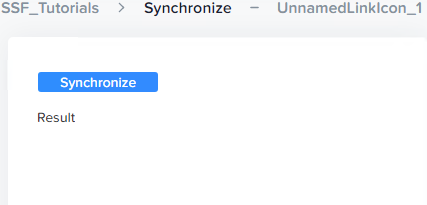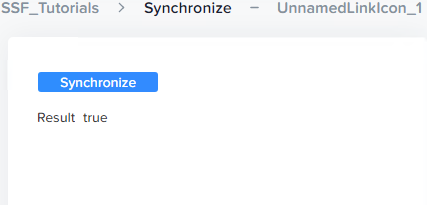Synchronizing logs
Introduction
Automatic synchronization of logs from controllers is normally made once every night. You can, however, initiate a synchronization at any time by executing some EXObasic.
In this excercise we will do just that using the Legacy context object.
Note
The complete view can be downloaded from here, but you will still need to follow some of the setup steps for it to work.
Setup
- In SSF_Tutorials, create a new
User Areacalled Synchronize. - Open Folder Views Tool and remove all the default
WidgetsandLink Icons. - Create a new
Link Iconand leave the default name as is (UnnamedLinkIcon_1).- Change the
(Global) Controllerargument to a controller that exists in your project
- Change the
In the File attribute, select Create a new view in this user area..., change the name to SynchronizeLogs.Rwav and save the the changes in Folder Views Tool.
Open the newly created view for editing.
- Remove the default elements.
- Add a
Buttonwith the name Synchronize. - Add a
Textelement with the name Result. - Save the file.
In your browser, navigate to the new User Area and make sure the elements display correctly.
Adding the server-side code
In the view root object, on the Javascript tab, open up the ServerSideJS editor and paste the following code:
return {
synchronize: async (args, callInfo) => {
// Macros work fine in ServerSide code
return await callInfo.context.legacy.execute('%Controller%.Synchronize');
}
}
Adding the client-side code
Open the OnManeuver editor for the Button and paste the following code. Make sure to save the view when done:
this.view.call('.synchronize', { }).then((result) => {
// result.executedOk returns true/false
this.view.Result.value(result.executedOk);
});
The result
Open your browser and navigate to the area. When your view loads it should look like this:

Click Synchronize and wait a couple of seconds. If all goes well you should get the following result:

Quick review
In this part we initiated a synchronization of logs from a controller using the Legacy context object. The name of the controller was passed in to the view as an argument, and we used a macro in the ServerSide code.
Ideas and improvements
You can execute any EXObasic code using this method so your imagination is the only limit here. Check out the EXObasic reference (in the EXOscada help) for inspiration.